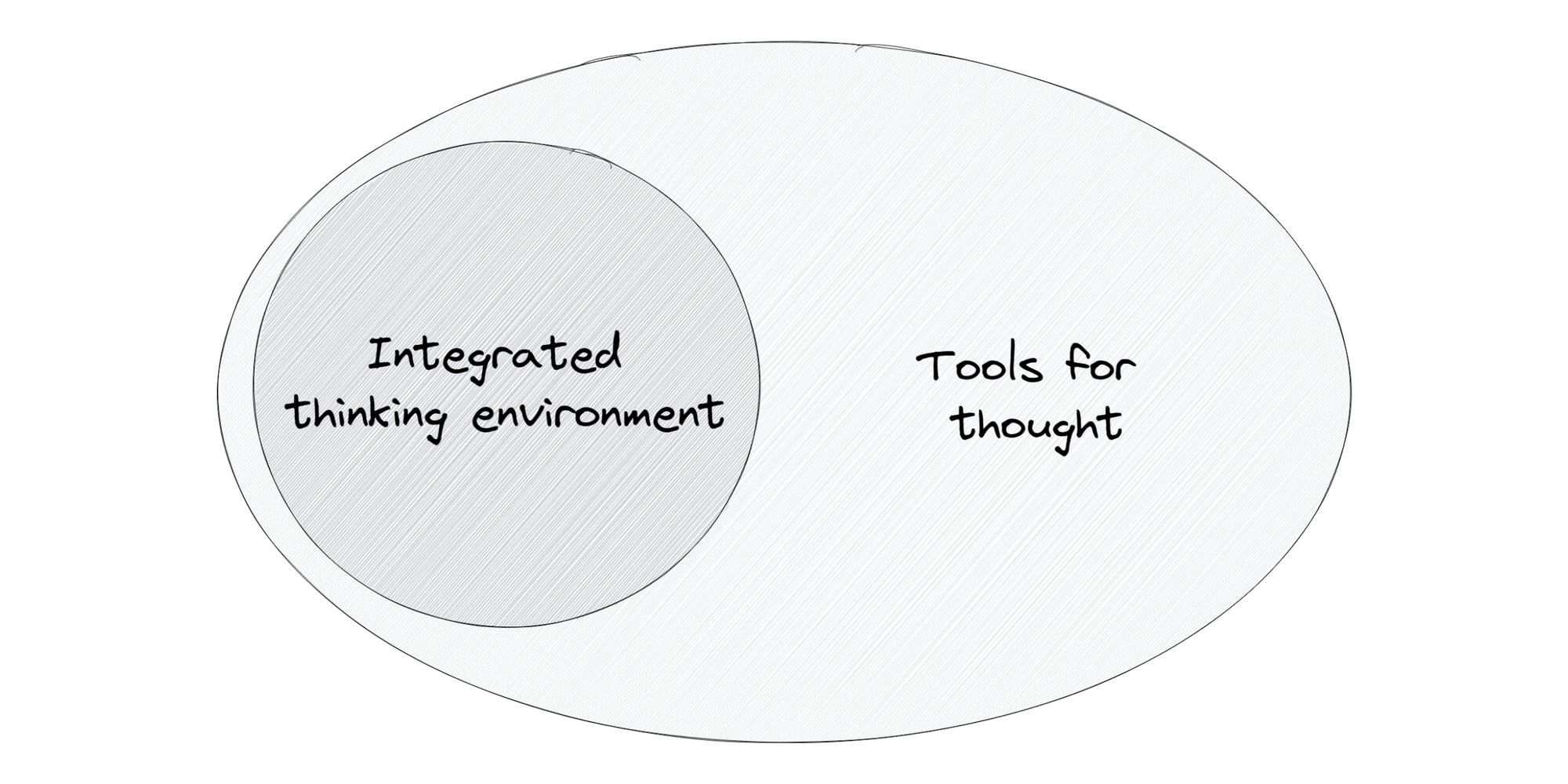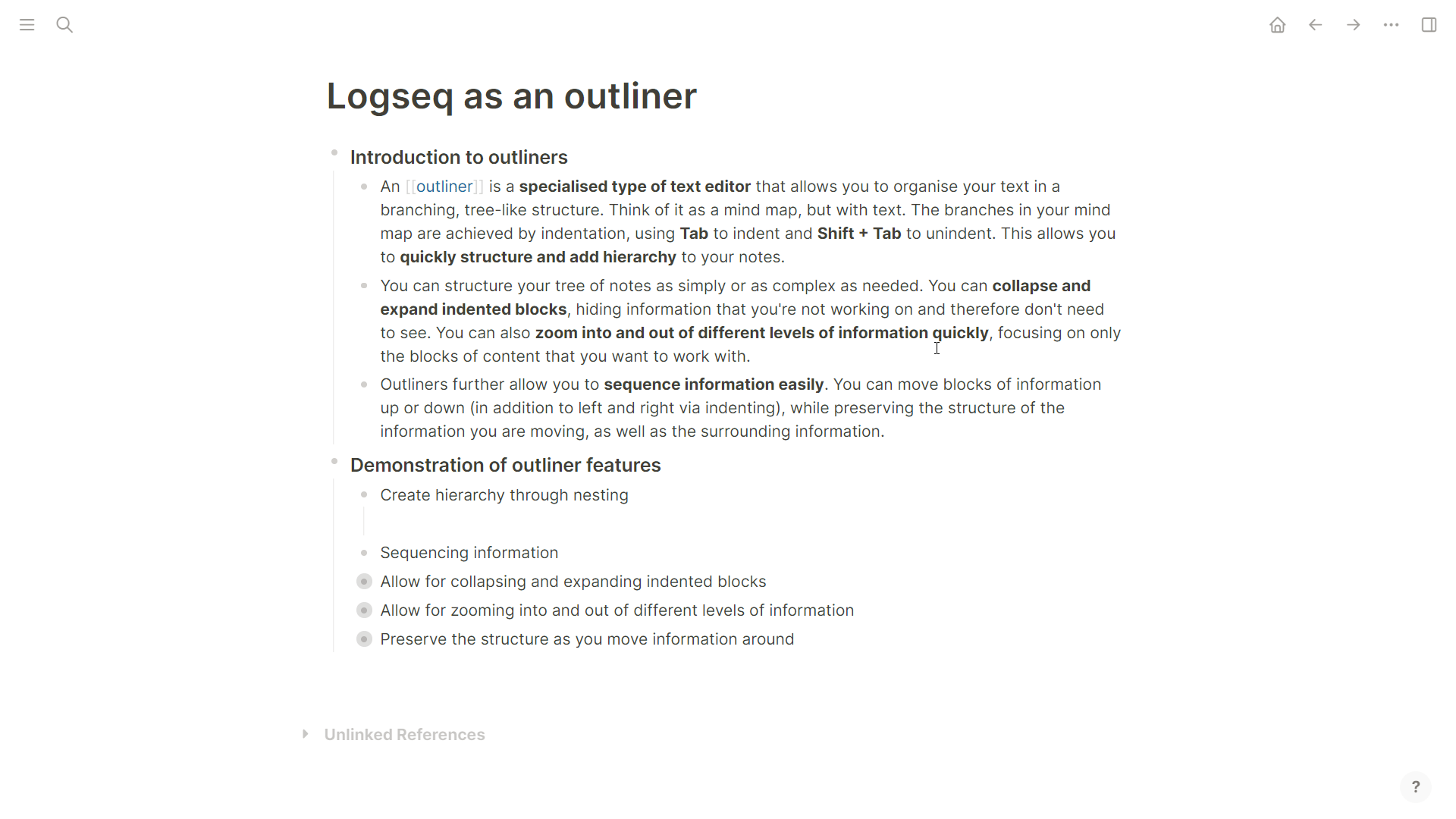Logseq and the Rise of the Integrated Thinking Environment
Every knowledge worker should have an Integrated Thinking Environment. Learn how Logseq can help you become more creative using outlines and links.

The ‘tools for thought’ space has exploded in the last few years. Tools such as Roam Research, Obsidian, RemNote, and even Notion allow users to manage their digital information in ways previously only accessible to hackers.
Despite this fierce competition, Logseq has emerged from humble beginnings to take its place as a leader in the field. I believe this is mainly because Logseq has three separate tools built into its DNA: a text editor, an outliner, and a bi-directional linking tool.
Whilst other tools may rely on plugins to achieve some of the functionality (e.g. the Outliner plugin in Obsidian), Logseq was designed from the bottom up to be a combination of the three. This makes Logseq a proper 'integrated thinking environment' (ITE); that is an “app that provides tools to make thinking easier, enabling us to be more innovative." (Ryan Murphy).
And no, an ITE is not another fancy acronym for ‘tool for thought’. Whilst all ITEs will invariably be ‘tools for thought’, the inverse is not valid. For example, a white-boarding application is a ‘tool for thought’ but not an ITE. An ITE goes beyond a single function, providing an all-in-one graphical user interface (GUI) to manage information, thereby facilitating improved thinking and original output. We’ll look into what differentiates an ITE later, but I’m sure there are a few eyebrows raised. Isn’t this just a solution, waiting for a problem?
Why do we even need an 'integrated thinking environment'?
It’s easy to dismiss the explosion of users switching to these new tools as hype. Technical terms like ‘bi-directional linking’ are difficult to grasp, and sales pitches aspiring to create a ‘worldwide connected knowledge graph’ sound aloof.
Most people don’t have the time or energy to explore outside their current toolset, and the new ways of working required by these tools can be an obstacle to adoption. And so, the average knowledge worker will continue juggling their current suite of applications, despite the shortcomings.
The question therefore arises, is there substance behind the hype? And why should I care about Logseq (or any other ITE, for that matter)?
Consider the example of the highly technical field of web development and software engineering. ‘Integrated development environments’ (IDEs) are a core tool in the developer’s toolkit. These IDEs provide an all-in-one GUI that consolidates the different aspects of writing code to solve complex problems. This includes editing source code, automatic syntax highlighting, debugging tools and workflow automation. Our modern technical infrastructure would be a few years (decades?) behind if it weren’t for the humble IDE. It’s a simple tool that facilitates complex problem-solving.
Consider now an array of other roles in the knowledge work economy. Our knowledge lies scattered across a range of applications. Tasks and reminders, reference documents, processes, meeting notes, ideas and overall project objectives are all scattered across apps and devices. Our information is typically stored in proprietary formats, only accessible via JSON exports (if we've chosen our application wisely). In an age where we create value by transforming knowledge, there are numerous friction points we need to overcome. We constantly incur switching costs as we access and process fragmented information to produce original output.
Imagine an alternate reality where you have all your information in one place, in an accessible user interface. Your files are stored in a simple text format that can be accessed by any application capable of reading text. You can jot down random reminders or write your magnum opus using outlines. Your information is densely linked, making it easier to find what you’re looking for and generate new connections. That is the world of the integrated thinking environment, the ITE.
I believe ITEs will be standard tools in the knowledge worker’s toolkit in years to come. I’d bet a fair sum that Logseq will be a leading name in the ITE space, just like VS Code and IntelliJ are highly regarded IDEs for coders. We’ll look at what an ITE should be able to do later in the article, but first, I’d like to take a closer look at each of the three tools built into Logseq’s DNA: text editor, outliner and a bi-directional linking tool.
Logseq as a text editor
Logseq allows you to work on text files in Markdown format. Markdown is a popular plain text format, like the .txt files that work with Notepad on Windows or TextEdit on macOS. The difference is that Markdown allows us to add formatting to plain text using special characters. For example, if I want to bold some words, I would simply add double asterisks before and after the words, e.g. **some words**.
Markdown is widely adopted and easy to use; even Google Docs is expanding its support of Markdown. The Markdown text files, recognised by the ‘.md’ file extension, are stored in the location of your choice (e.g. a folder on your desktop). This goes against the trend of modern note-taking and information management applications such as Roam Research, Notion and Evernote, which host your information on their own cloud databases.
With Logseq, you can still decide to host your notes on the cloud using a provider like iCloud or Google Drive, but you have complete privacy and portability because you own the files. You can open your files in any other text-editing application, and there is no risk of lock-in.
Logseq as an outliner
An outliner is a specialised text editor that allows you to organise your text in a branching, tree-like structure. Think of it as a mind map, but with text. Branches are achieved by indentation, using Tab to indent and Shift-Tab to unindent. This allows you to structure your notes quickly.
You can structure your tree of notes as simply or as complex as needed. You can collapse and expand indented blocks, hiding information that you're not working on and don't need to see. You can also zoom into and out of different levels of information quickly, focusing on only the blocks of content that you are working on.

Outliners further allow you to sequence information easily. You can move blocks of information up or down (in addition to left and right via indenting) while preserving the structure of the information you are moving and the surrounding information.
The graphic below illustrates how the outline structure transforms into branches of notes. You'll soon discover how the branching within an outline allows you to focus on one thing at a time whilst still allowing for that smaller unit to form part of a greater whole. This is what is meant by the word 'atomicity'.

Logseq as a bi-directional linking tool
Logseq’s primary drawcard is that it makes linking information easy. Bi-directional links provide a simple yet powerful feature set to add relationships between different notes in your note database at both the macro (page) and micro (block or paragraph) levels.
What makes bi-directional links so powerful is the creation of so-called 'back-links' in the page or block that is being referenced. When a link to a target is created at some source, another link is created in the target location, which points back to the original source. That means I can go to a page and see all the times that other pages have linked to it. This becomes a powerful way to collect your thoughts and information. You no longer have to navigate to a particular file to input information - you can input information anywhere in your database and easily retrieve it.
Bi-directional links also allow you to add multiple links to a single block, thereby building multiple associations to the information. How does this help our brains? Our brains are good at remembering things by association. The ‘Baker-baker’ paradox is a psychological phenomenon where a group of subjects find it easier to remember the keyword—baker— associated with a person when told that the person’s profession is ‘baker’, rather than their surname being ‘Baker’. This is because the profession of baker has many different associations in our minds. A network of thoughts already exists that link to the profession, such as the sights and smells of breads and pastries, the visual in your mind’s eye of the corner bakery and the baker standing with their apron. Similarly, using bi-directional links in Logseq allows you to create multiple different hooks of association, facilitating improved retrieval and allowing us to abandon the location-dependent desktop/folder paradigm in our organisational practices.
This realisation came months before I appreciated Logseq as a text editor or outliner in my own journey. It seems trivial, but it is a powerful shift in approach. I no longer had to think about where to find information or worry about where to store it. This allowed me to offload my continual anxiety around 'proper' organisation.
The graphic below illustrates the difference between mono-directional links (the traditional links on the internet) and bi-directional links.

How does Logseq’s combination of tools make it a standout integrated thinking environment?
Sure, Logseq is an impressive combination of tools, but how will this help you think better? After all, that's the main attraction of an ITE: an all-in-one GUI that improves thinking and original output. An ITE needs to meet a few criteria to do this.
Ryan Murphy (@ryanjamurphy on Twitter) has introduced the aptly-named 'NOTE' framework to describe the core features of an integrated thinking environment - Navigability, Organisability, Transformability and Extensibility. Let’s look at each of these and see how they pertain to Logseq.
Navigability speaks to the application's ability to navigate your collection of thoughts and information quickly and intuitively. Logseq's robust search and querying functionality, sidebars and various menus—not to mention the graph—tick the boxes for easy navigation. Bi-directional links also facilitate quick navigation as both source and target links are always available.
Organisability speaks to the features that allow you to structure and manage your information. Outlining is a crucial component of this. For everything else, there's bi-directional linking. Links enable you to build associations throughout your database, which means that each piece of information is available via multiple contexts. This surpasses the desktop/folder paradigm, which limits a bit of information to a single location.
Are you missing the folder approach? You can build 'maps of content' with links (check out Linking Your Thinking). These ‘MOCs’ function as an index or ‘table of content’ for your database. By pointing to all the pieces of information you wish to access frequently, you’re mimicking the functionality of a folder. Add in the toolset of page properties, block properties and namespaces, and you have a robust set of mechanisms for effective organisation.
Transformability speaks to the ability to use the content in your database as building blocks. For example, you may want to combine and reference different pieces of information and use queries to 're-display' information for a specific use case (e.g. managing a process). Logseq shines in this domain. You can think of any block of information in your Logseq database as a self-replicating LEGO brick, which can be used in multiple contexts. Logseq uses page references and block references to preserve the original information and build a rich network. Think of it as 'copy-paste' functionality on steroids.
Extensibility speaks to feature sets that allow you to access and use your information in customisable ways across various use cases, either through plug-ins or in other applications. Here is where Logseq's core capability as a text editor shows its strength. You can open your Logseq files with any application that can read text tiles, from a simple program such as Notepad to the powerful Obsidian. In addition, because Logseq is open-source and has community built into its DNA, there is a large community of developers building an extensive plugin ecosystem that further enhances the tool's extensibility.
Where to from here?
Logseq easily ticks the boxes of this ITE framework, but it’s still early days in this new category of tools. The requirements will evolve rapidly, and the framework will inevitably need to be revised.
At the moment, the framework focuses largely on an individual user. The question remains, how might the requirements shift to accommodate thinking in a team environment? Text will inevitably remain the fundamental unit of information storage, but users will demand ways to represent and organise information graphically. Many personal knowledge management enthusiasts yearn for the intuitive experience of arranging physical index cards or sticky notes to compose their thoughts. Surely our applications of choice should allow us to map information on a visual-spatial canvas and mark it up with hand-drawn elements on our mobile device of choice? And yes, I want to do it all in one application.
If you’re a fan of Logseq, you’ll be pleased to know that the development team is already working hard to make these features a reality. Real-time collaboration and white-boarding are current development priorities. There are many challenges to overcome, but if you've seen the development of the tool over the last two years, you won't doubt the team’s ability to develop a world-class product.
It doesn’t happen magically, but the Logseq team continues to make strong hires to support the challenging technical development and growing community. Logseq also recently secured $4.1 million in seed funding to make their dreams a reality. It seems like the stars are aligning.
Conclusion
I often feel like I’m on a Logseq soapbox. I firmly believe the tool will measurably improve people’s ‘digital well-being’, and thereby maybe their overall well-being, if only they would take the plunge.
It may sound high and lofty for some, but a personal note-taking practice is a slippery slope to improved self-management. I love what Tiago Forte says about note-taking:
Notetaking is just a trojan horse for self-awareness.
— Tiago Forte (@fortelabs) May 15, 2022
Almost everyone takes notes of some kind, be it using the default notes app on their phone or trusty pen and paper. Some take it further by using apps to manage multiple parts of their life and the accompanying streams of input and output. Before you know it, you’re entering the realm of personal knowledge management.
Through improved self-knowledge and with the ability to access information and resources seamlessly, I believe we can better solve problems and contribute to the world around us. However, change is hard, and time always feels like it’s rushing past. It might feel like transitioning your note-taking and information to Logseq is taking one step forward and two steps backwards as you learn how to work in different ways. But life is a marathon and not a sprint. Moving to Logseq might cause some short-term frustration, but I believe the long-term benefits far outweigh the costs.
If you’re new to Logseq, I hope your Logseq journey will be fruitful, and that you find as much joy as I have using the tool. I wish you the best of luck on your journey.
P.S. Struggling to get to grips with the tool?
It all sounds too good to be true. You get excited, open Logseq for the first time and encounter a blank journal page and the feeling of “now what?” sinks in. Many have felt this way. It’s impossible to deny that the transition into the world of Logseq can be intimidating. However, on the other side of the steep learning curve is a plateau of digital joy.
If you’re getting started and would like an in-depth guide to Logseq and how you can set up your own integrated thinking environment, have a look at my course, Logseq Mastery.
The course is divided into two units, which you can buy separately or in a bundle.
Unit 1 looks at 'Tutorials', which detail the building blocks of Logseq as a tool and how to develop effective approaches for input, organisation and retrieval of your notes and information. It also gets into some Logseq power features and principles for effectively maintaining your Logseq database.
Unit 2 looks at 'Workflows & Systems'. Once you understand Logseq's capabilities, you can build custom systems to manage your information. In this unit, I unpack how I've used Logseq to develop my own integrated thinking environment, including diagrams of my workflows and practical examples.
Here is the link if you’re interested 👉🏽 https://www.logseqmastery.com
